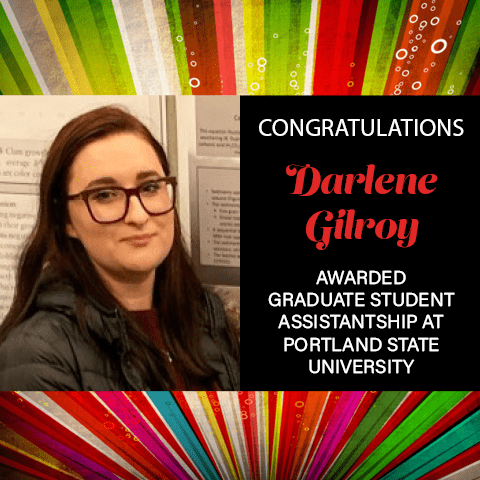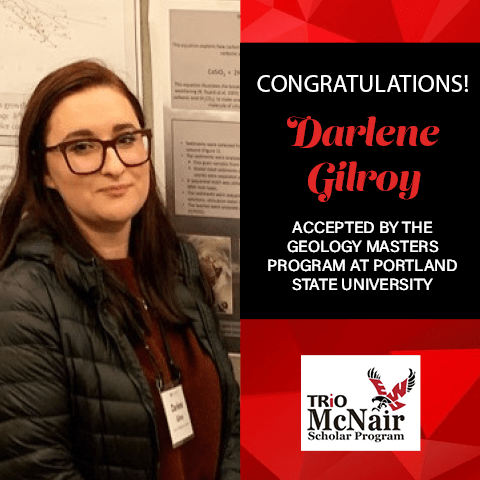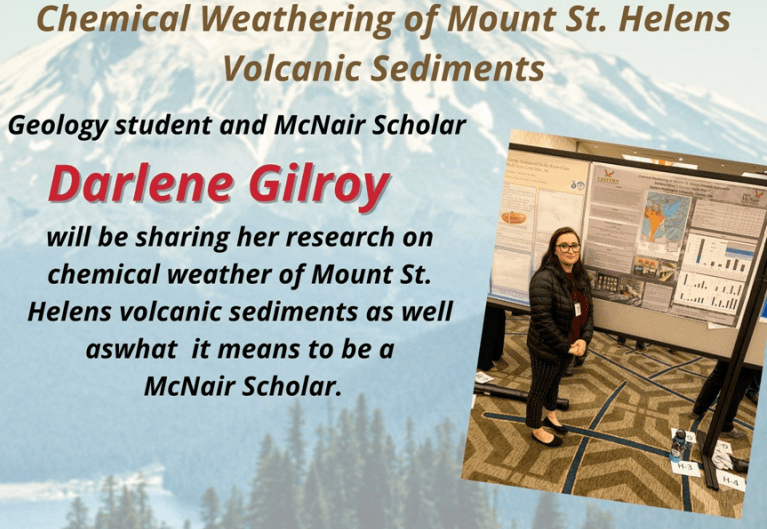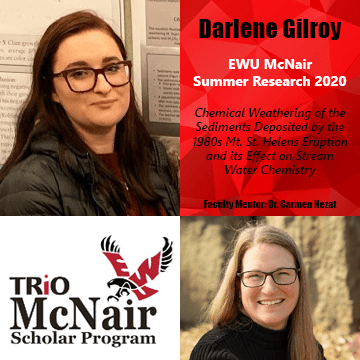Darlene Gilroy
Darlene Gilroy graduated from Eastern Washington University in summer 2021 with a bachelor of science degree in Geology. At EWU with the guidance of mentor Dr. Carmen Nezat, she worked on an independent research project investigating the chemical weathering of volcanic sediments (see research below), presenting this project at the 2019 Murdock College Science Research Conference in Tacoma WA, the 2020 WE-STEM conference at EWU, and the EWU Virtual Symposium. Darlene would like to focus future research in areas such as Anthropogenic Climate Change and Natural and Geologic Hazards, through the lens of Geochemistry.
For graduate school, she was accepted into the Master’s Program in Geology at San Jose State University, and the Master’s Program in Geology at Portland State University, where she began attending in Fall 2021. She is currently working as a Staff Geologist at GRI.
2019-2020 McNair Faculty Research Mentor: Dr. Carmen Nezat (Environmental Science)
Research Title: Chemical Weathering of the Sediments Deposited by the 1980 Mt. St. Helens Eruption and its Effect on Stream Water Chemistry
Abstract: Chemical weathering is an ongoing natural phenomenon that aids in the breakdown of solid rocks, and contributes to the chemistry of natural waters and soils. Therefore, studying chemical weathering in a given area may provide a better understanding of the natural influencers on nearby water chemistry. The eruption of Mount St. Helens (MSH) in 1980 provides a unique opportunity to study the chemical weathering of young rocks which typically weather more rapidly than older rocks. The aim of the study was to determine the relative resistance of the volcanic rocks from the 1980 MSH eruption to chemical weathering by using a sequential leaching process. Sediments were collected from the streams and leached with the following solutions to simulate chemical weathering: ultra-pure water (H2O), 1 N acetic acid (CH3COOH), and 1 N nitric acid (HNO3). The leaches were analyzed for Ca, Na, K, Fe, Mg, and Al using an inductively coupled plasma optical emission spectrometer (ICP-OES). Results show that each successive leach was capable breaking down more resistant minerals. Future research includes interpreting the composition of the leaches to determine which minerals each removed from the stream sediments.

EWU McNair Scholar Darlene Gilroy Awarded Graduate Student Assistantship at PSU

EWU McNair Scholar Darlene Gilroy Accepted by Geology Masters Program at San Jose State University

EWU McNair Scholar Darlene Gilroy Accepted by Geology Masters Program at PSU

EWU McNair Scholars Present their STEM Research and Experiences

EWU McNair Scholar Darlene Gilroy Completes Second Summer of Research

EWU McNair Scholar Darlene Gilroy Awarded Research Grant

Nine EWU McNair Scholars Present at Baylor McNair Research Conference

EWU McNair Scholar Darlene Gilroy Awarded Two Scholarships

18 EWU McNair Scholars Present at EWU Virtual Symposium




